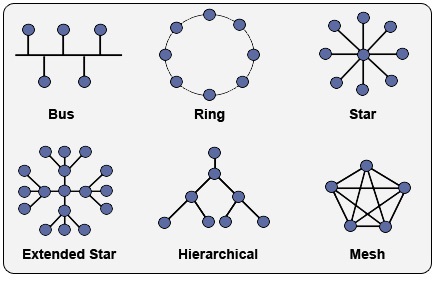Network Topology is the schematic description of a network arrangement, connecting various nodes(sender and receiver) through lines of connection.
Wired Topologies:
Network topological are categorized into Bus, Ring,Star,Tree,Mesh and Hybrid. Below fig shows the different types of topologies.

1. Bus: Bus topology uses one main cable to which all nodes are directly connected. The main cable acts as a backbone for the network. One of the computers in the network typically acts as the computer server. The first advantage of bus topology is that it is easy to connect a computer or peripheral device. The second advantage is that the cable requirements are relatively small, resulting in lower cost.
2. Star: In star topology, each computer is connected to a central hub using a point-to-point connection. The central hub can be a computer server that manages the network, or it can be a much simpler device that only makes the connections between computers over the network possible.
The advantages of a star topology are:
The disadvantages of a star topology are:
3. Ring: In ring topology, the computers in the network are connected in a circular fashion, and the data travels in one direction. Each computer is directly connected to the next computer, forming a single pathway for signals through the network. This type of network is easy to install and manage.
4. Hierarchical Topology: It is also known as the Tree topology. It can be considered as the combination of linear bus and star topologies as it contains systems with star topology connected to a linear bus main cable. There is dependency on the main linear bus line, and therefore any fault in this line can bring the entire segment down. However, this type of arrangement is supported by many hardware and software tenders. This topology is also known as expanded star topology. The configuration and wiring is difficult in comparison to other topologies. However, its point to point wiring for individual sections is a desirable feature of this topology.
5. Mesh Topology: In this type of arrangement every node participating in the network is connected to every other node. However, this tends to be very expensive and difficult to implement. Multiple paths are can be used for transmitting a message. Due to the presence of dedicated links, it does not provide any traffic problem.
6. Extended Star Topology: It refers to the arrangement which is basically an extension of star topology. An Ethernet network with several LANs extending beyond a single level may be seen as an Extended Star. Another topology that is commonly known is Hybrid topology, which is a combination of any two or more different types of network topologies. This arrangement is known for its flexibility and reliability.

Token Ring is an IEEE 802.5 standard whose topology is physically a star but logically a ring.
10BaseT is IEEE 802.3 standard whose topology is physically a star but logically a bus.
The 5-4-3 rule states that between any two nodes on the network, there can only be a maximum of five segments, connected through four repeaters, and only three of the five segments may contain user connections.
Wireless Topologies
Network topology is a layout of various elements of computer network, such as nodes, links, routers, etc. It is a network topological structure which can be depicted logically or physically.
Physical topology shows the physical location of network's components and cable connections between network nodes. Logical topology describes the data flows, the circulation of signals in physical topology. The physical and logical topologies for two networks can be identical, while their physical interconnections, the distances between nodes, transmission rates, and/or signal types may be differ
Infrastructure mode: The wireless network consist of at least one access point (AP) connected to the wired network and a set of wireless nodes (WN). This configuration is called a Basic Service Set (BSS). Extended Service Set (ESS) is a set of two or more BSSs (multiple cells).
Ad hoc mode: Also called "IEEE ad-hoc mode" or "peer-to-peer mode". This configuration is called Independent Basic Service Set (IBSS) and is useful for establishing a network where wireless infrastructure does not exist or where services are not required. Ad-hoc mode is used when devices or stations communicate directly with each other, without the use of Wireless Access Point (WAP). Ad-hoc mode is useful for establishing a network where wireless infrastructure is un-available or does not exist.
Extended Service Set (ESS) is a set of two or more Basic Service Sets (BSSes) working together to form a single wireless network. Stations are able to move between BSS within a single ESS yet remain "connected" to the fixed network and so continue to receive emails etc. As a Station moves into a new BSS, it will carry out a re-association procedure with the new AP (Access Point). Hotspot is an example of WLAN
Different Types of Networks:
LAN: A Local Area Network is a group of computers and network devices connected together, usually within the same building. By definition, the connections must be high speed and relatively inexpensive (e.g., token ring or Ethernet). A LAN connection is a high-speed connection to a LAN. For example, most of the buildings within a campus are connected using a LAN.
MAN: A Metropolitan Area Network is a larger network that usually spans several buildings in the same city or town. For example, if your organization has several buildings spread across the city, then they may be connected via MAN.
WAN: A Wide Area Network in comparison to a MAN, is not restricted to a geographical location, although it might be confined within the bounds of a state or country. A WAN connects several LANs, and may be limited to an enterprise (a corporation or an organization) or accessible to the public. The technology is high speed and relatively expensive. The Internet is an example of a worldwide public WAN.
The number of required WAN connections can be calculated with the formula w = n * ( n - 1) / 2, where w = the number of WAN links and n = the number of sites.
For example, a network with 10 sites would require 45 WAN connections to form a fully meshed network: 45 = 10 * (10 - 1) / 2.
ISDN is an example of WAN protocol.
18,000 feet is the maximum distance that a customer can be located from the central office for ISDN connectivity. If necessary, a repeater can be used to increase the distance limitation.
In a full mesh topology, each network node is connected to every other network node. This type of inter connectivity results in highest level of redundancy.
PAN: A Personal Area Network (PAN) is a computer network used for data transmission among devices such as computers, telephones and personal digital assistants. PANs can be used for communication among the personal devices themselves (intrapersonal communication), or for connecting to a higher level network and the Internet (an uplink).
Infrared(IR) and Near-field communications(NFC) are examples of PAN
WPAN: A Wireless Personal Area Network is a PAN carried over wireless network technologies such as Bluetooth, wireless USB etc.
Both WiMAX and LTE are 4G (4th Generation) cellular technologies. One of the biggest advantages of LTE over WiMAX is its compatibility with all previous mobile technologies GSM, GPRS, UMTS, WCDMA, CDMA, CDMA200, EV-DO.
WiMAX network doesn't support legacy systems like 2G and 3G. WiMAX is a better choice for the low cost installing network. Both WiMAX and LTE can theoretically reach between 10 and 50 Mbps connection speeds, though actual speeds may depend on several factors and rarely reach the max speeds. WiMAX is an example of WirelessMAN
High Speed Packet Access (HSPA+) is considered a 3.5 generation technology. It has greatly improved data rates over its HSPA forerunner. Because HSPA+ can use an all-IP architecture, it has the potential to evolve into a true 4G technology.
Technologies that facilitate the Internet of Things(IoT):
Bluetooth: It is widely used from smart phones to personal gadgets. It operates in the 2.4 Gigahertz ISM band. Bluetooth signals typically travel over a distance of 10 to 300 feet. Because Bluetooth uses radio frequencies, the devices do not have to be within line of sight of each other.
ANT devices may use any RF frequency from 2400MHz to 2524MHz, with the exception of 2457MHz, which is reserved for ANT+ devices. ANT+ is built on top of the proven ultra-low power ANT protocol, the network is optimized for power consumption, cost, latency, robust communication and ease of implementation. Over all, ANT and ANT+ standards are widely adopted for IoT and uses 2.4GHz ISM band of frequencies.
Zwave (or Z wave or Z-wave), developed by zensys, is a protocol for communication among devices used for home automation. It uses RF for signaling and control. Zwave operates at 908.42 MHz in the US (868.42 MHz in Europe) using a mesh networking topology. Each Z-Wave network is identified by a Network ID and each device is further identified by a Node ID.
IR, short for Infra Red, requires line of sight communication.
NFC is a set of short-range wireless technologies, typically requiring a separation of 10 cm or less. NFC operates at 13.56 MHz.

